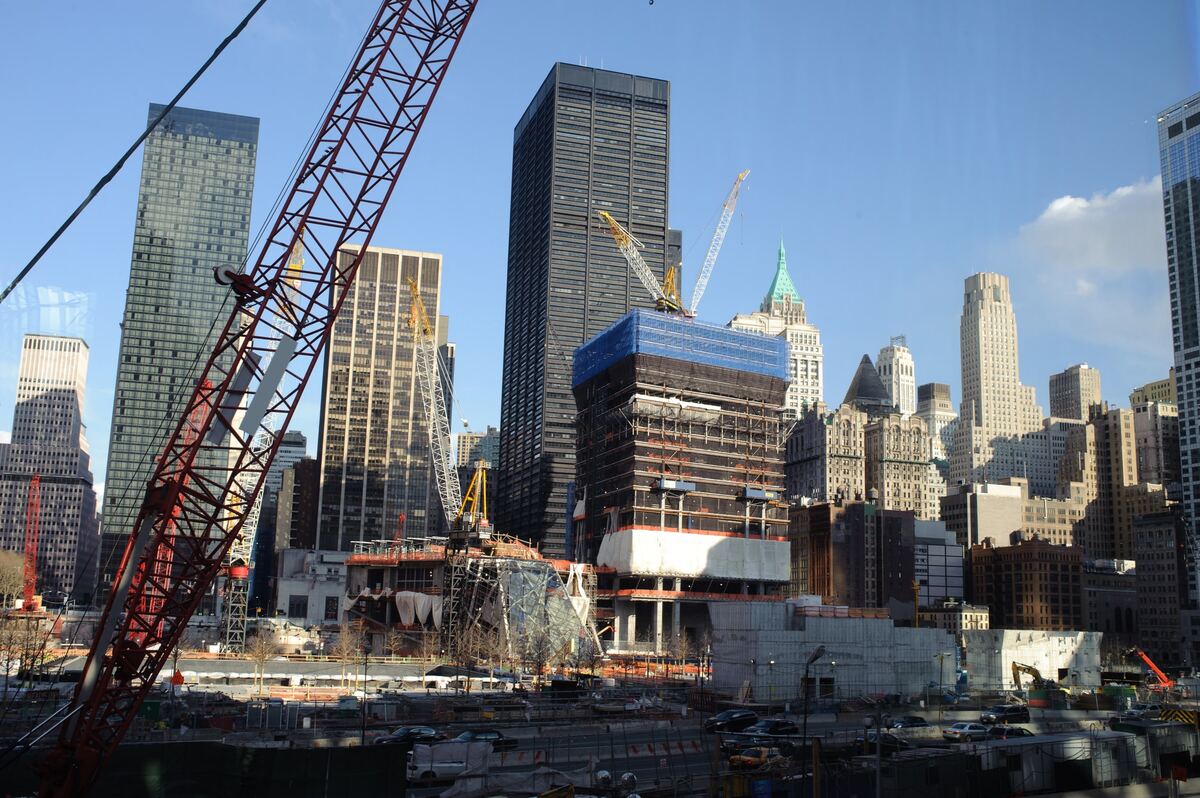Home>diy>Building & Construction>What Is The Biggest Construction Project In The Western World In The Last 4,000 Years?


Building & Construction
What Is The Biggest Construction Project In The Western World In The Last 4,000 Years?
Modified: January 6, 2024
Discover the biggest construction project in the Western world in the last 4,000 years! Learn about the remarkable feat of building-construction that has stood the test of time.
(Many of the links in this article redirect to a specific reviewed product. Your purchase of these products through affiliate links helps to generate commission for Storables.com, at no extra cost. Learn more)
Introduction
Throughout history, mankind has undertaken ambitious construction projects that have left a lasting impact on civilization. From ancient wonders to modern marvels, these monumental structures showcase the ingenuity and engineering prowess of humanity. In this article, we will explore some of the biggest construction projects in the western world over the last 4,000 years.
These projects serve as a testament to human innovation, perseverance, and the desire to push the boundaries of what is possible. From colossal pyramids to awe-inspiring skyscrapers, each endeavor has its unique story and significance. Join us on this journey as we delve into the details of these extraordinary feats of construction.
Whether they were built to serve practical purposes or to signify power and grandeur, these monumental structures have captivated the imagination of people around the world for centuries. From ancient civilizations to modern-day societies, these projects have become iconic symbols of human achievement and cultural heritage.
As we explore these remarkable endeavors, we will not only admire the sheer magnitude and architectural brilliance but also delve into the historical and cultural contexts in which they were built. So, let’s begin our exploration of the biggest construction projects in the western world, spanning thousands of years of human history.
Key Takeaways:
- Monumental construction projects like the Pyramid of Giza, Great Wall of China, and Burj Khalifa showcase human ambition, cultural heritage, and technological prowess, leaving a lasting impact on society for millennia.
- These engineering marvels not only connect nations and foster unity but also serve as symbols of human determination, collaboration, and the relentless pursuit of progress, inspiring awe and admiration across generations.
The Pyramid of Giza
The Pyramid of Giza, also known as the Great Pyramid of Khufu, is one of the most iconic and enduring symbols of ancient Egypt. Constructed over 4,500 years ago during the Old Kingdom period, it stands as the oldest and largest of the three pyramids located on the Giza Plateau, just outside Cairo.
Believed to be the tomb of the Pharaoh Khufu, the pyramid is an architectural masterpiece. It was built using an estimated 2.3 million limestone blocks, each weighing an average of 2.5 tons. This incredible feat of engineering required the coordination of thousands of skilled laborers and took around 20 years to complete.
The Pyramid of Giza originally stood at an impressive height of 146.5 meters (481 feet), though erosion and the loss of its outer casing stones have reduced its current height to approximately 138 meters (455 feet). Despite this, it remains the tallest pyramid ever built.
The pyramid’s interior is equally remarkable. It features a complex network of passages, chambers, and corridors, including the leading burial chamber where the pharaoh’s sarcophagus was placed. Intricate hieroglyphics adorn the walls, depicting religious and funerary scenes, while hidden shafts have sparked endless speculation and debate among historians and archaeologists.
One of the most astounding aspects of the Pyramid of Giza is its precise alignment with the cardinal directions. It was built with such accuracy that its sides are almost perfectly aligned with the four points of the compass. This alignment is a testament to the advanced astronomical knowledge possessed by the ancient Egyptians and serves as a reminder of their deep connection with the cosmos.
The Pyramid of Giza continues to fascinate and mystify people from around the world. It has stood the test of time and remains an enduring symbol of ancient Egypt’s architectural prowess and cultural heritage. Today, it stands as a UNESCO World Heritage Site and attracts millions of visitors who come to marvel at this enduring wonder of the ancient world.
The Great Wall of China
The Great Wall of China is perhaps one of the most remarkable construction projects in history. Spanning thousands of kilometers across the northern borders of China, it is an architectural marvel that stands as a testament to the country’s rich history and cultural heritage.
Originally built to protect against invasions and raids from various nomadic tribes, the construction of the Great Wall began over 2,000 years ago during the Qin Dynasty and continued through subsequent dynasties. Over the centuries, the wall underwent expansion and renovation to fortify China’s borders.
The wall stretches for an astounding 21,196 kilometers (13,171 miles) and is made up of a series of interconnected walls, towers, and fortresses. It snakes its way across rugged mountains, valleys, and plains, traversing diverse landscapes and offering breathtaking views along its entirety.
In some sections, the wall reaches a height of up to 8 meters (26 feet) and is wide enough for soldiers to walk atop it. The construction utilized a variety of materials, including earth, stone, brick, and wood. The wall’s resilience was achieved through ingenious engineering techniques, such as the use of layered bricks and stone slabs held together with sticky rice mortar.
The Great Wall of China is not a single continuous structure but rather a series of interconnected sections. Some of the most famous sections include Badaling, Mutianyu, and Jinshanling. These sections have been preserved and renovated, allowing visitors to experience the grandeur and historical significance of the wall.
Today, the Great Wall of China is recognized as a UNESCO World Heritage Site and serves as a symbol of Chinese culture, unity, and human perseverance. It attracts millions of tourists each year, who come to explore its architectural splendor, learn about its historical significance, and take in the breathtaking landscapes that surround it.
The Great Wall of China is an enduring testament to human ambition and determination. It stands as a reminder of China’s rich history and the ingenuity of its ancient builders. Visiting the Great Wall is not just a trip through time but a journey of awe and admiration for one of the greatest engineering achievements in the world.
The Roman Colosseum
The Roman Colosseum, also known as the Flavian Amphitheatre, is an iconic symbol of the ancient Roman Empire. Located in the heart of Rome, Italy, it is one of the most well-preserved and recognizable ancient structures in the world.
Construction of the Colosseum began in 70 AD and was completed in 80 AD during the rule of Emperor Vespasian. This massive amphitheater was designed to host various forms of entertainment, including gladiatorial contests, animal hunts, and mock naval battles, in front of an audience of up to 50,000 spectators.
The Colosseum’s architecture is awe-inspiring. It is a circular structure with an elliptical arena at its center. The outer walls, made of concrete and travertine stone, reach a staggering height of 48 meters (157 feet) and are adorned with architectural features such as arches, columns, and statues.
Inside the Colosseum, a complex system of underground tunnels and rooms called “hypogeum” housed staging areas for the gladiators, as well as animals and equipment. Trapdoors and elevators allowed for dramatic entrances and exits during the spectacles.
Despite centuries of neglect and natural disasters, including earthquakes and fires, the Colosseum remains an iconic symbol of Roman engineering and grandeur. Restoration and preservation efforts have helped maintain its structural integrity and allow visitors to experience its historical significance.
Today, the Roman Colosseum is a popular tourist destination, attracting millions of visitors from all over the world. It offers a glimpse into the ancient world and provides insight into the brutal but captivating spectacles that took place within its walls.
Beyond its architectural and historical importance, the Colosseum serves as a reminder of the grandeur and power of the Roman Empire. It stands as a testament to the creativity, engineering skills, and cultural significance of the ancient Romans.
Visiting the Roman Colosseum is like stepping back in time and immersing oneself in the rich history of one of the greatest civilizations to have ever graced the earth. The Colosseum’s enduring legacy as a symbol of Rome continues to inspire and captivate people to this day.
The Panama Canal
The Panama Canal is an engineering marvel that revolutionized global trade and transformed the way ships navigate between the Atlantic and Pacific Oceans. Located in the country of Panama, this 48-mile-long (77 kilometers) waterway connects the Caribbean Sea to the Pacific Ocean, providing a vital shortcut for international shipping.
The idea of constructing a canal through Panama had been envisioned for centuries, as it would eliminate the need for ships to sail around the treacherous and time-consuming journey around Cape Horn at the southern tip of South America.
Construction of the Panama Canal began in 1904 by the United States and was completed in 1914, with its official opening taking place on August 15th of that year. The project faced numerous challenges, including treacherous terrain, tropical diseases like malaria and yellow fever, and the need to overcome the enormous task of excavating mountains and building locks.
The canal utilizes a system of locks to raise and lower ships as they pass through the differing water levels of the Gatun Lake and the Pacific and Atlantic Oceans. This enables vessels of various sizes to safely navigate through the canal, reducing travel time and providing a more efficient transportation route.
The construction of the Panama Canal had a profound impact on global trade and maritime commerce. It greatly reduced travel distances and expenses for ships, expanding trade routes and facilitating the transportation of goods between the East and West coasts of the Americas.
Fast forward to the present day, the Panama Canal remains an essential artery of international trade, handling about 5% of global maritime commerce. It serves as a vital link in the supply chain, enabling the transportation of goods and commodities from one ocean to another with relative ease.
Visiting the Panama Canal is a fascinating experience, allowing visitors to witness the ingenuity and engineering mastery required to create this remarkable waterway. It offers a unique opportunity to see ships passing through the locks, marvel at the immense machinery, and learn about the history and significance of this incredible feat of human engineering.
The Panama Canal stands as a testament to human determination and the ability to overcome seemingly insurmountable challenges. Its impact on global trade and transportation continues to resonate, making it one of the most significant construction projects in the western world.
The biggest construction project in the Western world in the last 4,000 years is the Great Wall of China, stretching over 13,000 miles.
Read more: Where Is The Biggest Trampoline In The World
The Hoover Dam
The Hoover Dam, located on the border of Nevada and Arizona in the United States, is an architectural marvel that harnessed the power of the mighty Colorado River. Named after President Herbert Hoover, the dam was completed in 1936 and stands as a testament to human ingenuity and resourcefulness in the face of adversity.
The construction of the Hoover Dam was a monumental project that aimed to provide water supply, flood control, and hydroelectric power to the growing southwestern region of the United States. It required the cooperation and effort of thousands of workers, who braved harsh conditions and extreme temperatures during the height of the Great Depression.
The dam itself is an impressive structure, stretching for 1,244 feet (379 meters) across the Black Canyon and rising to a height of 726 feet (221 meters). It was constructed using over 4.3 million cubic yards (3.3 million cubic meters) of concrete, an extraordinary amount for its time, making it one of the largest dams ever built.
The main purpose of the Hoover Dam is to provide hydroelectric power. It generates clean and renewable energy that supplies electricity to millions of homes, businesses, and industries in the surrounding states. The dam’s power plant produces an average of 4.5 billion kilowatt-hours of electricity each year.
Another crucial role of the Hoover Dam is its contribution to water management in the arid southwestern region of the United States. The dam regulates the flow of the Colorado River, ensuring sufficient water supply for agriculture, municipal use, and sustaining delicate ecosystems downstream.
Visiting the Hoover Dam offers a unique opportunity to witness this incredible feat of engineering up close. The panoramic views of the dam and the surrounding landscape are awe-inspiring, providing a profound appreciation for the magnitude of human achievement. Guided tours provide insight into the dam’s history, construction, and its ongoing impact on the region.
The Hoover Dam serves as a symbol of American resilience and innovation. It stands as a testament to the ability of humans to tame nature and harness its resources for the greater benefit of society. The dam remains a source of pride and inspiration, showcasing the remarkable capabilities of human engineering and the positive impact it can have on communities and the environment.
The Channel Tunnel
The Channel Tunnel, also known as the “Chunnel,” is a remarkable feat of engineering that connects the United Kingdom and mainland Europe. This underwater tunnel stretches beneath the English Channel, linking Folkestone in Kent, England, with Coquelles near Calais in northern France.
Construction of the Channel Tunnel began in 1988 and was completed in 1994, after several years of meticulous planning and collaboration between the two countries. This ambitious project aimed to create a direct and efficient transportation link between the UK and Europe, facilitating trade, tourism, and cultural exchange.
The Channel Tunnel consists of three interconnected tunnels: two for rail traffic and a smaller service tunnel for maintenance and emergencies. Each tunnel measures 50 kilometers (31 miles) in length, with the majority being located underwater, up to 75 meters (250 feet) below the sea bed.
One of the greatest challenges of building the Channel Tunnel was the need to excavate through layers of soft chalk and clay under the seabed. Innovative engineering techniques, including the use of advanced tunnel boring machines, were employed to create stable and secure tunnels capable of withstanding the harsh marine environment.
The completion of the Channel Tunnel revolutionized cross-channel travel, providing a more convenient and time-efficient alternative to ferry services. High-speed Eurostar trains now transport passengers between London, Paris, and Brussels, reaching speeds of up to 300 kilometers per hour (186 miles per hour) through the tunnel.
Not only did the Channel Tunnel facilitate the movement of people, but it also significantly transformed the transportation of goods between the UK, Europe, and beyond. It opened up new opportunities for trade and commerce, creating a seamless link for the movement of goods by rail.
Today, the Channel Tunnel remains a vital conduit for trade, tourism, and cultural exchanges between the UK and Europe. It has become a symbol of connectivity and unity, enabling people to bridge geographical boundaries and foster closer ties between nations.
Traveling through the Channel Tunnel is an experience that showcases the remarkable achievements of modern engineering. The seamless journey between the UK and France and the breathtaking views of the sea seem to disappear as the train glides smoothly through the tunnel.
The Channel Tunnel stands as a testament to human determination, innovation, and international cooperation. It is a testament to the power of human ingenuity to overcome geographical barriers, connect nations, and shape the future of transportation.
The Burj Khalifa
The Burj Khalifa, located in Dubai, United Arab Emirates, is an architectural marvel and a symbol of human ambition and engineering excellence. Standing at a staggering height of 828 meters (2,717 feet), it is the tallest structure in the world and an iconic landmark on the Dubai skyline.
Construction of the Burj Khalifa began in 2004 and was completed in 2010. It was designed by the renowned architectural firm Skidmore, Owings & Merrill, with the vision of creating a masterpiece that would not only break records but also showcase the modern and futuristic aspirations of Dubai.
The Burj Khalifa features a unique Y-shaped design, which not only provides stability for the structure but also maximizes the space available for residential and commercial use. The exterior is adorned with reflective glass panels and stainless-steel cladding, reflecting the ever-changing sky and creating a stunning visual spectacle.
One of the extraordinary aspects of the Burj Khalifa is its vertical transportation system, consisting of 57 elevators and 8 escalators. These state-of-the-art lifts can reach speeds of up to 10 meters per second (33 feet per second), whisking occupants to unimaginable heights in a matter of seconds.
The tower not only boasts awe-inspiring height but also houses a mix of residential, commercial, and hospitality spaces. It features luxurious apartments, corporate offices, world-class restaurants, observation decks, and even a hotel, known as the Armani Hotel Dubai.
Notably, the Burj Khalifa’s observation decks, located on the 124th and 148th floors, offer breathtaking panoramic views of Dubai and its surroundings. Visitors can witness the city’s stunning skyline, the vast Arabian Desert, and the glistening waters of the Persian Gulf.
Beyond its architectural significance, the Burj Khalifa serves as a symbol of Dubai’s transformation and progress as a global city. It has become an international icon, attracting millions of tourists each year who come to marvel at its height, architectural brilliance, and the unparalleled views it offers.
The Burj Khalifa also plays a vital role in sustainability, incorporating innovative features such as a condensate collection system, LED lighting, and a high-performance curtain wall to minimize the building’s environmental impact.
The Burj Khalifa is more than just a skyscraper; it is a testament to human innovation, ambition, and the relentless pursuit of pushing boundaries. It stands as a symbol of Dubai’s global stature, its commitment to progress, and its vision of a future where architectural wonders continue to redefine what is possible.
The International Space Station
The International Space Station (ISS) is not just a construction project but a testament to human collaboration and the pursuit of scientific exploration beyond Earth’s boundaries. Orbiting approximately 400 kilometers (250 miles) above the Earth’s surface, the ISS serves as a remarkable symbol of international cooperation and scientific achievement.
The construction of the ISS began in 1998 and involved the collaboration of multiple space agencies from around the world, including NASA, Roscosmos, ESA, JAXA, and CSA. It was a groundbreaking endeavor that aimed to create a habitable space laboratory that could support long-duration human space missions.
The ISS is a marvel of engineering, consisting of multiple modules that were launched separately and then meticulously assembled in space. These modules include living quarters, laboratories, observatories, and docking ports for spacecraft, such as the iconic Soyuz capsules and the Space Shuttle.
One of the primary objectives of the ISS is to conduct scientific research in a microgravity environment. The unique conditions on the station allow scientists to explore a range of disciplines, including biology, physics, astronomy, and human physiology. Research aboard the ISS has led to significant discoveries and advancements, from understanding the effects of long-duration spaceflight on the human body to developing technologies that benefit life on Earth.
The ISS is also a testament to human endurance in the harsh conditions of space. Astronauts from different nations have lived and worked on the ISS, conducting experiments, maintaining the station, and pushing the boundaries of human exploration. Their dedication and bravery in venturing beyond Earth’s atmosphere pave the way for future space endeavors.
Moreover, the ISS serves as a platform for international collaboration and fostering peaceful relations between nations. The cooperation and partnership among the various space agencies involved highlight the power of unity and the shared goal of expanding humanity’s horizons in space.
From its vantage point in orbit, the ISS offers awe-inspiring views of our planet. Astronauts onboard can witness breathtaking sunrises and sunsets, city lights sparkling at night, and the beauty of Earth’s natural features, reminding us of the fragility and interconnectedness of our world.
The International Space Station represents the collective achievement of humanity in space exploration. It stands as a symbol of our innate curiosity, the spirit of discovery, and the potential for international collaboration. As we continue to explore outer space, the ISS will always hold a special place as a testament to our capacity for innovation and the boundless wonders that await us beyond Earth’s atmosphere.
Read more: What Is The Biggest Construction Vehicle
Conclusion
Throughout history, mankind has undertaken monumental construction projects that have left a lasting impact on society. From ancient wonders like the Pyramid of Giza and the Roman Colosseum to modern marvels like the Burj Khalifa and the International Space Station, these remarkable endeavors showcase human ingenuity, ambition, and the ability to push the boundaries of what is possible.
These construction projects serve as symbols of human achievement, cultural heritage, and technological advancement. They captivate the imagination of people from all walks of life, inspiring awe and admiration for the incredible feats of engineering and architecture that have shaped our world.
Whether it be the pyramids that stand as a testament to the power and grandeur of ancient civilizations, the Great Wall of China that showcases the ingenuity and perseverance of humankind, or the modern marvels that redefine skyscrapers and explore outer space, each project tells a story of human ambition and the pursuit of progress.
These construction projects have not only transformed landscapes but have also impacted human society. They have facilitated trade, transportation, and cultural exchange, connecting nations and fostering a sense of unity among people across borders.
Moreover, these structures have become iconic symbols of pride for their respective regions and countries, drawing millions of visitors each year who come to witness their magnificence, learn about their history, and appreciate the dedication and craftsmanship that went into their creation.
As we marvel at these engineering marvels, it is important to recognize the collective efforts, collaboration, and sometimes sacrifices made by countless individuals to bring these projects to life. From the architects, engineers, and laborers to the visionaries and leaders who dared to dream, these projects exemplify what human determination and collaborative spirit can accomplish.
Additionally, these construction projects serve as a reminder of our responsibility to preserve and protect our architectural heritage and natural wonders. They represent our connection to the past and our commitment to future generations, inspiring us to continue pushing boundaries and embarking on new frontiers.
In conclusion, the biggest construction projects in the western world over the last 4,000 years stand as testaments to human imagination, creativity, and innovation. From the mysteries of the ancient pyramids to the modern feats that reach towards the heavens and space, these endeavors provide a window into our history, our aspirations, and our limitless potential.
Frequently Asked Questions about What Is The Biggest Construction Project In The Western World In The Last 4,000 Years?
Was this page helpful?
At Storables.com, we guarantee accurate and reliable information. Our content, validated by Expert Board Contributors, is crafted following stringent Editorial Policies. We're committed to providing you with well-researched, expert-backed insights for all your informational needs.














0 thoughts on “What Is The Biggest Construction Project In The Western World In The Last 4,000 Years?”